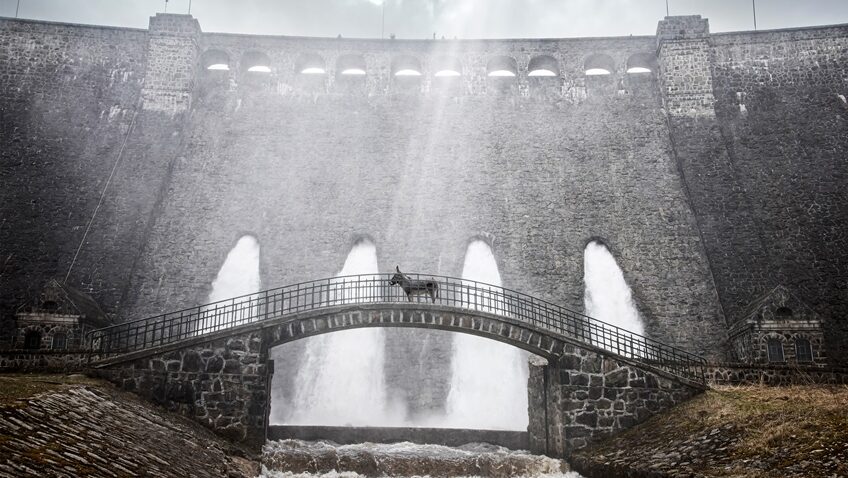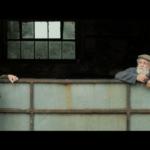Joyce Glasser reviews EO (February 3, 2023) Cert 15, 88 mins.
You don’t normally associate animal movies with older film directors. Walt Disney, whose recipe for success was a few tragic tears but a happy ending, gave us Dumbo, and Bambi in his prime, and Lady and the Tramp in his fifties, but his movies were family fare. Disney died in 1966, the year his contemporary, French director Robert Bresson, released a biopic of a farm donkey, Au Hasard, Balthazar, at the age of 65.
Now at age 84, Polish actor, writer and director Jerzy Skolimowski, who began his career co-writing Roman Polanski’s Knife in the Water, and went on to direct The Departure, Deep End and The Menacing Eye, chooses a Bressonian donkey as his first animal protagonist. Like Bresson’s film, it is not intended for young children.
Donkeys are naturals on screen, but we read into their melancholic, guileless faces our own emotions. Skolimowski knows that their helpless innocence, coupled with their hapless fates, will melt our hearts. He enhances this anthropomorphism somewhat with the use of reaction shots; strobe lighting that might suggest emotions and distinct flashbacks or memories. But primarily the effect is obtained by the contrast between our anxiety and the donkey’s ignorance of what is in store for him.
If Balthazar starts as a baby donkey being baptised by innocent children on a farm – to suggest the idea that animals are God’s creatures – when we meet E0, he is already grown. His onomatopoeic name is only endearing to one person: the circus dancer Kasandra (Sandra Drzymalska), who performs with the donkey in the ring. She feeds him carrot muffins, talks to him and caresses him in his spacious pen. To EO the circus life is donkey heaven.

To animal rights activists, however, circuses represent animal cruelty and have no place in the modern world. The protesters give little thought to the donkey’s future once the circus, minus its animals, is forced to close. Despite the required disclaimers about no animals being harmed in the making of this film there may come a point when activists will turn on the use of animals in the film industry itself, although here six different donkeys shared the limelight, and the workload.
In any event, EO is separated from Kasandra and taken to stables with the circus horses. Through no fault of his own, and unable to express himself in his own defence, when a trophy case is knocked down, EO’s stay at the stables comes to an end. He is sent to a farm, from which he escapes in search of those carrot muffins.
As in Balthazar, EO is separated from the one person who cares about him. In Balthazar, it was a girl named Marie (continuing, the religious parable that begins with the donkey’s baptism), played by Anne Wiazemsky who went on to star in La Chinoise and then to marry Jean-Luc Godard in 1967. We all have our journeys and burdens in life.
Charles Dickens has shown us that it’s harder for a boy who has once known kindness, trust and comfort to be orphaned, starved, lost, sold or trafficked into a more abusive situation than vice-vera, and so does Skolimowski, writing with his regular co-writer Ewa Piaskowska. Skolimowski knows we will impose our own feelings on the donkey’s innocent, unreadable face, and throughout the rest of his life, EO will be wondering why things had to change when he had it so good.
There is an eerie stretch when EO wanders into a forest where we hear wolves, but he is unharmed by other animals or nature. The journey is so unpredictable that you keep watching to see what’s next in store for the animal. Pawel Mykietyn’s electronic score signals that this is no fairy tale. The score, along with Michal Dymek’s (Supernova) cinematography give the story a monumental weight and scope.

When EO leaves the forest he experiences his first football game, and, like too many games, things turn nasty. He makes the mistake of braying at a penalty kick, causing the distracted player to miss. The losing team is furious. The winning team adopt the lucky donkey as their mascot and leave him out to grass while they celebrate in a tavern that night. But the losing players are sore losers and attend the party to take no prisoners. After beating up the humans, the thugs turn to EO, who is innocently chomping the grass.
After a stint in a veterinary hospital and various other adventures, EO is saved by a wandering hippie, Vito (Lorenzo Zurzolo), whose character is the strangest in the film – to the point of distraction. He seems to be a priest, or a mama’s boy who imagines himself to be a priest. We know he is spiritual because he begs EO’s forgiveness for eating salami. When Vito takes the animal home to a grand, if somewhat neglected château with manicured gardens, we want to breathe a sigh of relief. But that’s before Isabelle Huppert appears in a cameo as the Countess who starts throwing plates across the kitchen, apparently lamenting their financial straits.
EO’s journey is episodic and at every turn we wait for the worst to come. But there is no real order to the various adventures and even when EO crosses borders (he starts in Poland and seems to end up in Italy) the narrative lacks direction. That might be the point. We are seeing the world through the donkey’s eyes and it cannot be easy for a simple animal to process all that he is going through.
The film is a scathing indictment of man’s inhumanity toward beast, powerful enough for it to have been nominated for an Academy Award for Best International film. But although made for a new generation, the film cannot escape comparison with Bresson’s masterpiece.
If you want to see previous films by this director check out: OUTSIDERS AND EXILES: THE FILMS OF JERZY SKOLIMOWSKI, presented in partnership with the 21st Kinoteka Polish Film Festival running at BFI Southbank from 27 March – 30 April.




